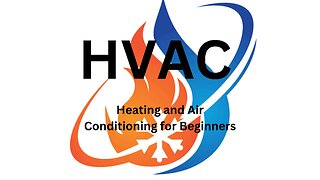Premium Only Content

function of the Thermostat and control board
In an HVAC (Heating, Ventilation, and Air Conditioning) indoor unit, the control board plays a vital role in managing the overall operation of the system. It serves as the central control hub, responsible for coordinating various functions and ensuring the efficient and effective operation of the unit. Here are some key functions of the control board in an HVAC indoor unit:
System Control: The control board manages the overall operation of the HVAC system. It receives input from various sensors and thermostats and controls the different components of the unit accordingly, including the blower motor, compressor, fan, and damper actuators.
Temperature Regulation: The control board monitors the temperature inside the space being conditioned and compares it to the desired temperature set by the user. It adjusts the operation of the heating or cooling components to maintain the desired temperature within a specific range.
Mode Selection: The control board allows users to select different operating modes such as heating, cooling, fan-only, or auto mode. It interprets the mode selected and adjusts the operation of the HVAC system accordingly.
Fan Control: The control board regulates the operation of the indoor unit's blower fan. It controls the fan speed based on the user's settings or the system requirements, ensuring proper airflow through the system.
Safety Controls: The control board incorporates various safety features to protect the HVAC system and prevent any potential hazards. It monitors parameters such as system pressure, temperature limits, and electrical current. If any abnormal conditions are detected, the control board can shut down the system and activate safety measures.
Communication Interface: Many modern HVAC control boards feature communication interfaces such as Wi-Fi or wired connections. These interfaces enable the unit to connect to external devices or a central control system for remote monitoring, control, and diagnostics.
Troubleshooting and Diagnostics: The control board often includes diagnostic capabilities to assist technicians in troubleshooting system issues. It may have LED indicators or error codes to provide information about specific faults or malfunctions within the HVAC system.
-
 28:35
28:35
HVAC for beginners
1 year ago $0.05 earnedhow to diagnosis a gas furnace
3051 -
 LIVE
LIVE
SynthTrax & DJ Cheezus Livestreams
1 day agoFriday Night Synthwave 80s 90s Electronica and more DJ MIX Livestream CHROMIUM Edition
160 watching -
 LIVE
LIVE
GritsGG
12 hours agoBO7 Warzone Is Here! Win Streaking! New Leaderboard?
46 watching -
 LIVE
LIVE
VapinGamers
3 hours ago $0.28 earnedDestiny 2 - Star Wars Renegade Lightsabers Oh My! - !rumbot !music
136 watching -
 2:13:17
2:13:17
TheSaltyCracker
4 hours agoPipe Bomb Bull Sh*t ReeEEStream 12-05-25
81.8K166 -
 LIVE
LIVE
DannyStreams
2 hours agoBF the WZ
18 watching -
 LIVE
LIVE
Finfante
3 hours ago $0.07 earned*Interactive Stream* Something is WRONG. (Dane Jonson). | LIVE INDIE HORROR NIGHT
26 watching -
 21:51
21:51
DBoss_Firearms
9 hours ago $0.16 earnedHeaded to The Gathering with some friends!
3.37K -
 58:48
58:48
Flyover Conservatives
22 hours agoUnmasking Antifa: Inside the Red–Green Revolution Aimed at the U.S. Constitution - Kyle Shideler | FOC Show
15.2K26 -
 55:26
55:26
Sarah Westall
4 hours agoJobs Losses Hit the Millions, Real Estate Nightmare, Repo Markets, & more w/ Andy Schectman
20.9K9